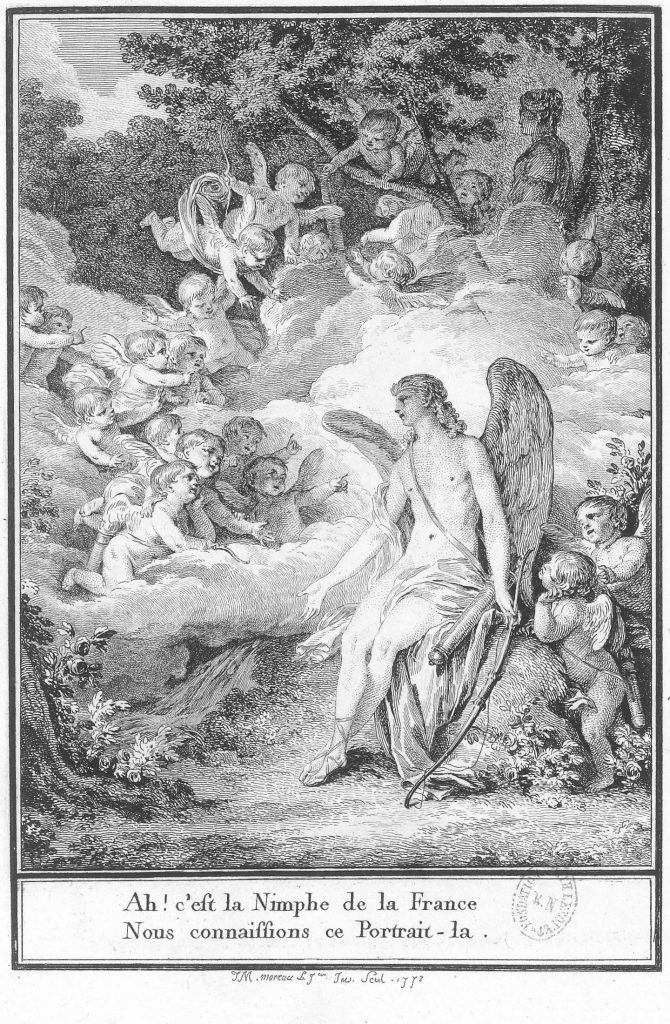


Look:
View Image(s): Chantilly, 1773, Compare
Image Metadata:
Image Description:
The scene is set within a bosquet, or garden grove, identified in the lyrics of the song as the grove of Cupid’s mother, Venus, who appears in profile in a shadowy representation in the upper right of the print. The brightly lit centre of the image, achieved in the intaglio etching process by leaving the plate unmarked, draws our attention to the central figure of Cupid, identified with his attributes of wings, bow and quiver, who appears as ‘L’aîné des amours’ [the eldest of the putti]. The little putti surround him as he plays a game with them to guess the object of his desire – not Psyche, this time, as the poem tells us, but another ‘Nymphe’ from the earthly realm. To the right of Cupid a putto puts his hand to his ear to show us that he’s listening, while to the left the raised hands and pointing fingers of three putti indicate that they have worked out the riddle, as we read in the legend below “Ah! c’est la Nimphe de la France/Nous connaissons ce Portrait-la” [Ah! It’s the Nymph of France/ We recognise that Portrait there].
The Nymph of France is perhaps the personification of that Country, not shown in Moreau’s print, but frequently depicted in history paintings that celebrate the reign of the French monarchs. This image draws from the broader tradition of the divine approbation of France, a subject dealt with in many previous works, but perhaps most famously in Peter-Paul Rubens’ cycle of paintings celebrating the life of Marie de Medici. It also belongs to the tradition of scenes of the loves of the gods, a popular subject for Roman baroque painters (notably the Carracci ceiling for the Palazzo Farnese), which was enthusiastically renewed in eighteenth-century France by François Boucher, among others. Moreau’s design in the Chantilly album is the reverse of the print, as to be expected from a process of etching a plate, and copying from a sketch without the use of a mirror—a technique used by some engravers of the period to reverse the design and thus preserve the orientation of the image in the final print. While the design and print are very similar, we can see that Moreau has changed the representation of Venus from that of a young woman with flowing hair looking down upon the scene in the design, to a more sober woman in profile, with her hair tied up in an elaborate style recalling busts of Greco-Roman goddesses, or perhaps those of Roman matriarchs.
Plate Signature: “JM. moreau Le Jne. Inv[?]. Scul. 1772”
Artist: “Moreau, Jean Michel”
Engraver: “Moreau, Jean Michel”
Year: 1772
Inscription: “Ah! c’est la Nimphe de la France / Nous connaissions ce Portrait – la.”
Keywords:
arrows, bosquets, bows (weapons), Cupid (Roman deity), day (time of day), exterior, fog Nymph of France, putti (children), quivers, Rosa (genus), sandals, sculpture (visual works), statues, trees, nudes (representations) naked male body, wings (animal components)
Texts which refer to this image: Mahérault, L’oeuvre de Moreau le jeune, 24
Other works of art quoted in this image:
General Metadata:
Group Page Range: Vol. 1, 6-10
Title Page Inscription: “LE / PORTRAIT / RECONNU”
Published Notes:
Listen:
View Score(s): 1773
Song 1 recording: Dans un des Bosquets de sa Mére
Song 2 recording: Qui par fortune trouvera
Credit: Paul McMahon, tenor
Amy Moore, soprano
Erin Helyard, harpsichord (French double by Carey Beebe after Blanchet, 1991)
Temperament: Jean-Henri Lambert, 1774, A:392
Song 1 diction recording:
Song 2 diction recording:
Credit: Eighteenth-century diction prepared and declaimed by Linda Barcan with the assistance of Erin Helyard and Veronique Duche
Music Metadata:
Song 1 Description:
This charming chanson is particularly well-suited as the first song in a large collection dedicated to the Dauphine of France. Written in her honour, the chanson is set as a gavotte. With clear periodic phrasing and a gentle and sinuous melodic line it sets the lyrical and structural tone for the Choix de Chansons. J.-J. Rousseau (1768) wrote that the gavotte, while usually a ‘gay’ dance, could also be slow and tender. Its compatibility with French prosody and its ability to suit a variety of temperaments made it a favoured choice for composers of chansons. Most of the repetitions in the accompaniment (including the petite reprise) are here characterised by increased surface activity, which suggests a certain kind of ardent effusion, a sentiment found in the poetry.
S.1.01.1.mid
S.1.01.1.mid
Song 1 Composer: [Laborde, Jean-Benjamin de]
Song 1 Key Signature: Bb
Song 1 Time Signature: 2
Song 1 Expression Marks: Andantino
Song 1 Tessitura of Voice: f1-bb2
Song 1 Tessitura of Instrument: F-c3
Song 1 Strophic: Strophic
Song 1 Related Compositions:
Song 2 Description:
Song 2 Composer: [Laborde, Jean-Benjamin de]
Song 2 Key Signature: g
Song 2 Time Signature: 6^8
Song 2 Expression Marks: Allegretto
Song 2 Tessitura of Voice: d1-g2
Song 2 Tessitura of Instrument: D-eb2
Song 2 Strophic: Strophic
Song 2 Related Compositions:
Read:
Song 1 Transcription:
I
Dans un des Bosquets de sa Mére,
L’aîné des amours assembla
tout le peuple aîlé de Cythére,
que de fripons se trouvaient là!
Psiché, dit-il, m’avait sû plaire;
un autre me tient sous ses loix:
Par le portrait que j’en vais faire,
devinez l’objet de mon choix.
Par le portrait que j’en vais faire,
devinez l’objet de mon choix.
II
Son front annonce une Déesse,
Son cœur n’en a pas la fierté;
Sa beauté ravit, intérésse;
Sa grace ajoute à sa beauté.
Dans ses yeux l’Esprit etincelle:
Rien n’est si doux que ses accents;
Et sa bouche est la fleur nouvelle
Eclose au souffle du printems.
III
A ces mots on cause, on murmure,
Sur qui leur choix est-il tombé?
Chacun devine à l’aventure:
L’un nomme Flore, et l’autre Hébé
Eh! quoi? leur dit, avec finésse,
Le plus malin des petits Dieux,
Quand l’amour veut une Maitresse;
Va-t-il la chercher dans les Cieux?
IV
Que fait l’éclat du rang suprême,
Reprit son frere avec ardeur?
Ah! sans lui la Nimphe que j’aime
N’en eut pas moins séduit mon cœur:
On la verroit, simple Bergére,
Regner encor par les attraits;
Son empire, c’est l’art de plaire;
Elle aura toujours des sujets.
V
L’Hymen lui trésse une couronne
Les plaisirs portent ses couleurs;
L’éssain des Jeux, qui l’environne,
Lui présente un scéptre de fleurs.
Toutà coup plein d’impatience,
Le chœur des Amours s’écria:
Ah! c’est la Nimphe de la France,
Nous connoissions ce Portrait-là.
Song 2 Transcription:
I
Qui, par fortune, trouvera
Nimphes dans la prairie,
cette qui tant plus lui plaira,
tenés, c’est bien ma mie.
si quelqu’une vient à danser,
et d’une grace telle qu’elle
ne fait les fleurs verser,
Eh bien, c’est encor elle.
II
Si quelqu’un dit, avec serment,
Je donnerois ma vie,
Pour être aimé, rien qu’un moment;
Tenez, c’est de ma mie:
Si quelqu’ autre fuit, sans espoir,
La Nymphe qu’il adore;
Content du charme de la voir;
Eh bien! c’est elle encore.
III
Eglé vint aux jeux de Cérès,
Et fut d’abord suivie;
Eglé revint le jour d’aprés,
On ne vit que ma mie.
Si quelque Nymphe a le crédit
D’étre toujours nouvelle,
A voz yeux comme à votre esprit,
Tenez, c’est toujours elle.
IV
L’autre matin, sous ces buissons,
Une Nymphe jolie,
Me dit: j’aime tant vos chansons:
Je dis, c’est pour ma mie;
Pour célébrer ses doux attraits.
Fait t’on chanson nouvelle.
En y songeant, l’instant d’après,
On chante encor pour elle.
V
Je lui sçais maint adorateur,
Et n’en ai jalousie;
Amour a mis tout mon bonheur
Dans celui de ma mie:
Que serviroit de m’allarmer?
La chose est naturelle;
Annette est faite pour charmer.
Et nous pour n’aimer qu’elle.
Text Metadata:
Song 1 Incipit:
Song 1 Text Description:
Dans un des bosquets de sa mere
Song 1 Author: “Dorat, Claude Joseph”
Song 1 Text Keywords:
Sources that refer to song 1 text: Sautreau de Marsy, Oeuvres choisies de M. Dorat 3, 335-336
Sources that song 1 text refers to: Possible reference to the Ballet des Polonais, commissioned by Catherine de Médicis in 1573.
Song 2 Text Description:
Song 2 Incipit: Qui par fortune trouvera
Song 2 Author: “Moncrif , François-Auguste Paridis de”
Song 2 Keywords:
Sources that refer to song 2 text: Laborde, Essai sur la musique 4, 256





